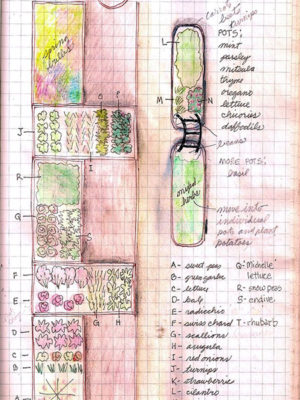Take Copious Notes!
What’s in the Garden:
Back in the day, a certain history teacher from Midland Park High School named Lawrence Saling used to entreat his students to take copious notes and study them nightly. This advice served many of us well both as scholars and as gardeners.
Keeping a garden journal is an excellent way to track your successes (and failures) from one growing season to the next. While these notes won’t need to be studied nightly, they will help you remember which plant varieties you will want to purchase again, or grow from seed. You’ll also be able to easily recall those plants you meant to try, but never did.
 For starters, include sketches of your garden and the full names of the plants in each bed. Each time you add perennials, bulbs, or annuals, be sure to note their location in your journal. When planting bulbs, as so many people do each fall in anticipation of the spring spectacle, add garden tags/labels to mark the spot, since nothing will be visible for several months. This will help stop those disappointing moments when you’re about to plant something new and you dig into the dirt with gusto, only to find that you’ve handily sliced into a dormant, but otherwise healthy, bulb.
For starters, include sketches of your garden and the full names of the plants in each bed. Each time you add perennials, bulbs, or annuals, be sure to note their location in your journal. When planting bulbs, as so many people do each fall in anticipation of the spring spectacle, add garden tags/labels to mark the spot, since nothing will be visible for several months. This will help stop those disappointing moments when you’re about to plant something new and you dig into the dirt with gusto, only to find that you’ve handily sliced into a dormant, but otherwise healthy, bulb.
When you add something new to your landscape, add a corresponding entry that includes the date of the planting, the name of the plant (the Latin name, too), and when it blooms.
Be sure to note whether the bed enjoys full sun, partial sun, or mostly shady conditions. It is helpful to observe when the sun hits the bed, since some plants dislike full sun in the heat of the summer.
Have you added shrubs or trees that have increased the amount of shade in your yard? Maybe you, or a neighbor, lost a tree, and the amount of sunshine has increased. This information is vital to the success of the plants in your garden, so take notes!
Make notations when, and how much, you fertilize, mulch, water, and prune your plants.
If you have your soil tested each year, keep the results and list any amendments you make.
Remember to jot down the names of the plants that performed well in your container gardens and window boxes. If you want to replicate these plantings next year, all you’ll have to do is consult your journal and bring us your list.
As you write, be sure to note:
- Successes
- Discoveries
- Varieties to Try in the Future
This writer’s 2016 successes included using Bumper Crop organic soil amendment and Deer Out repellant. Discoveries included Angelonia, Bacopa, Pentas, Twisted Arrows, Tall Ageratum, Curly Spider Plant, and Plumbago. Spring 2017 will include plantings of Kangaroo Paw, Scavola and Verbena as groundcover, and Cleome as a “thriller.”
What will be in YOUR garden?

